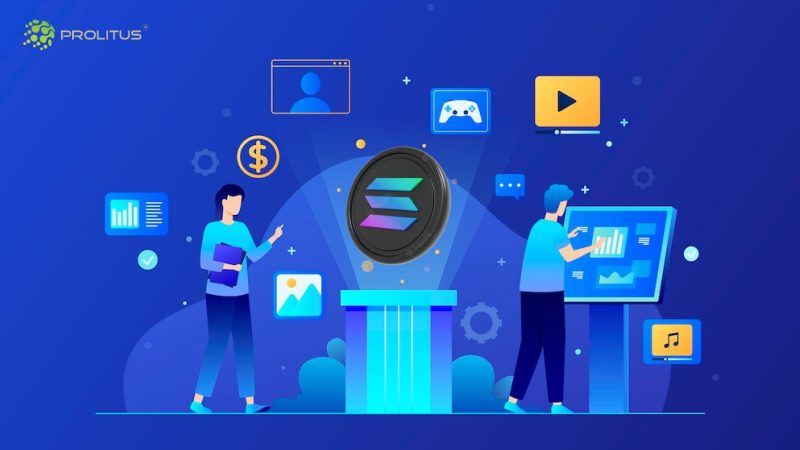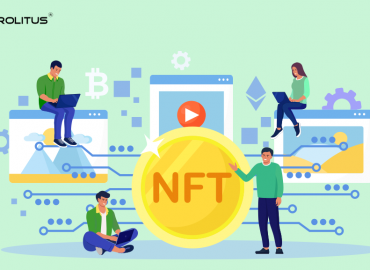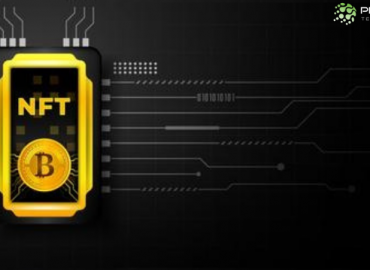Non-Fungible Tokens, aka NFTs, have taken various industries by storm in the past two years. This is because they solve multiple traditional issues that seem hard to tackle, like ownership rights, originality concerns, interoperability, and transparency. And it’s not just businesses who are adopting this new technology; celebrities, athletes, and individuals are also tokenizing their assets.
But where can these NFTs be traded?
Here is where the usability of the NFT Marketplace comes into play, where all of these digital assets get traded. Thus, in recent times, the number of NFT Marketplaces has also surged. Many blockchain networks provide the development of the NFT Marketplace, but the most prominent among them is the Ethereum blockchain network. However, Ethereum is continuously losing its market share to other blockchain networks like Solana, Avalanche, Binance Smart Chain, Cardano, etc., due to various drawbacks with the Ethereum blockchain. Some of the major ones include high gas fees and low transactions per second (TPS), which Solana handles very efficiently.
Thus, this article will focus on developing Solana NFT Marketplace and get the complete inside out of it.
What is an NFT Marketplace?
The NFT Marketplace acts as an intermediary platform that allows users to mint, buy, and sell digital assets, which can be anything from an ape image to virtual appeals. Generally, the buying and selling of these NFTs happen through crypto, so it becomes mandatory for users to have a crypto wallet. However, some NFT marketplaces only allow payments in the form of their own tokens, which users first need to buy at a predetermined price.
Thus, the NFT Marketplace is similar to e-commerce platforms, which allow buying and selling of physical goods and products.
Why should you develop the NFT Marketplace on Solana?
The Solana blockchain is a fast, secure, and scalable platform designed to support decentralized applications, including NFT marketplaces. Solana’s high transaction processing capabilities allow for fast and efficient transactions, making it an ideal choice for NFT marketplaces that require seamless and secure transactions.
Solana also provides robust security features, including cryptographic signatures and cryptographic proof-of-stake consensus, which ensure the authenticity and integrity of NFT transactions. Solana’s decentralized infrastructure also provides increased transparency and decentralization, making it a popular choice for NFT marketplaces looking to provide a secure and transparent marketplace for their users.
Moreover, Solana has various other features that have made it stand ahead of different blockchain networks. So let’s look at these features one by one.
1. No Mempool Problem
Mempool is a waiting area for transactions that aren’t confirmed and waiting to be added to a block. It is one of the most frequently encountered issues with blockchains like Ethereum. But Solana overrides the issue of mempool, which directly boosts the transaction speed. Thus, the Solana-based NFT Marketplace has the edge over others in that the transactions aren’t left unconfirmed for a long time.
2. Programmability
Solana uses the Rust programming language to develop NFT Marketplace, Dapps, and other applications. However, it should be noted that Rust is comparatively hard to learn compared to Solidity, but it provides features like scalability and customization. Thus, Solana-based NFT Marketplaces are highly customizable, and developers can easily modify the functionality and working of the NFT Marketplace.
3. Interoperability
Solana provides robust interoperability; thus, NFT Marketplace built on Solana supports buying and selling NFTs across multiple platforms. This ensures that the true moto of decentralization isn’t destroyed, and traders enjoy the flexibility of moving their NFTs across various NFT platforms.
4. High-Speed Transaction
Solana supports speeds up to 400 milliseconds and around 65,000 transactions per second (TPS). Due to such high-speed infrastructure, Solana can efficiently manage a large volume of transactions on the NFT Marketplace.
5. Low Transaction Fees
The transaction fee on Solana is around $0.00025, which is significantly lower than other blockchain networks. Thus, lower transaction fees and additional features like high-speed transactions and interoperability make it a highly lucrative and ideal platform for developing an NFT Marketplace.
6. Scalability
The Solana ecosystem provides high scalability by ensuring that the network handles high transaction volumes and is easily expandable when required. Thus, global expansion and network congestion are never a problem with Solana-based NFT Marketplace.
7. Liquidity
Liquidity plays a crucial role for traders in the NFT Marketplace because if there is a lack of liquidity, prices will increase, and higher prices will discourage both buyers and sellers from doing the transactions. Thus, Solana ensures that liquidity is high by providing features like interoperability, high transaction speed, low transaction cost, etc.
Steps to Develop a Solana NFT Marketplace
Below is a step-by-step process through which you can develop your Solana-based NFT Marketplace, so let’s go through it.
1. Choose the Type of NFT Marketplace
The first and foremost thing is to choose the type of NFT Marketplace you want to develop based on your end objective. There are mainly two types of NFT Marketplace:
Generalized NFT Marketplace
On this kind of NFT platform, almost all types of NFTs are traded, including art, gaming, collectibles, sports, music, etc. Thus, it is a generalized platform for all buyers and sellers of NFTs.
Specialized NFT Marketplace
On this kind of NFT platform, only specific types of NFTs are traded. For example, an NFT platform solely dedicated to NBA sports collectibles like NBA Top Shot. Thus, it is a specialized platform that targets and serves only specific kinds of buyers and sellers of NFTs.
From the above, it is clear that you can get more users in the generalized platform, while in the specialized platform, you get highly dedicated and concentrated users. So it’s your final call depending on the business requirements and objective.
2. Choose the Features of the NFT Marketplace
Now that you are done selecting the type of NFT Marketplace, it’s time to make a list of features you would love to have in your NFT Marketplace. Of course, there are various features that you can include and make your NFT Marketplace lucrative, but let’s look at a few of the most commonly used features:
Popular NFTs
A list of popular NFTs can be showcased to all platform users based on the number of bids or views from the users.
Top buyers and sellers
Buyers and sellers who bought and sold the most NFTs can be listed as top buyers and sellers.
Bidding history of a user
Every user can see their bidding history and the current status of all those bids.
Push notifications
You can send push notifications for every user’s activity on the platform, for example, after buying/selling off an NFT, adding funds to the wallet, successfully placing a bid for an NFT, etc.
Search bar with various filters
Users can use the search bar to specifically search for particular NFTs or use filters to search and sort as per their requirements.
3. Choose an NFT Marketplace Development Company
You now have a list of features to be embedded in your NFT Marketplace and are also clear about the type of NFT Marketplace you want, so it’s time to knock on the door of experts. Leading companies in the NFT Marketplace development space, like Prolitus, can help you turn your idea from paper to existence. They are the ones who can not only provide the required technical support but also help you with guidance and various insights, which can give you an edge over others. Thus, it’s always best to approach the experts in the field instead of taking the entire pain yourself.
4. Choose a Monetization Strategy
Now that you have onboarded an NFT Marketplace Development company, it’s time to sit with them and choose a relevant monetization strategy. There are various strategies in use, but the most commonly used ones are:
Monetization through listing charges
In this monetization strategy, each listing of an NFT on the platform is charged by the NFT Marketplace.
Monetization through subscription fees
This monetization strategy is rarely used as platform users are charged a fee yearly, half-yearly, or monthly. Generally, specialized NFT Marketplaces use this kind of monetization strategy as they serve a concentrated target audience.
Monetization through NFT sales
This is the most widely used monetization strategy in which each sale of NFT is charged a fee as the platform acts as a deal provider for the sale of NFT.
5. Develop the Frontend and Backend of the NFT Marketplace
It’s time to jump to the heart of the development process, which is building the NFT Marketplace. Everything from UI/UX to writing the logic of smart contracts, which acts as a backbone for the NFT Marketplace, takes place at this step. So it takes a significant amount of time to build a properly functional NFT Marketplace. Thus, as an alternative, consider developing a Whitelabel NFT Marketplace, as it is comparatively easy to create and takes less time.
6. Beta Testing and Launching
Your NFT Marketplace is fully developed, but one more step is left to complete before the launch. Beta testing is essential to ensure no bugs or errors in the NFT Marketplace. Because if you miss any of the security loopholes, then your NFT Marketplace may face some serious threats from hackers.
If no bugs are found in the best testing, then you can finally launch your NFT Marketplace. And in the other case, you should first fix the bugs, conduct beta testing, and continue the loop until you get no bugs in the test results.
7. Customer Support and Maintenance
Finally, now that you have launched your NFT Marketplace, it’s time for customer support and maintenance. It is the last part but also an equally important one for the success of your NFT Marketplace. So if you don’t have a customer support team who handles the customers’ queries, and if you aren’t undertaking regular software maintenance and upgrades, then your NFT Marketplace won’t scale up and may end up in the graveyard.
Thus, it’s necessary to provide 24*7 customer support and perform regular software maintenance and upgrades per the requirements.
Prolitus: Solana NFT Marketplace Development Company
Attention all NFT enthusiasts! Are you looking for a reliable and efficient platform to launch your own NFT marketplace? Look no further! Our Solana NFT marketplace development company has got you covered.
Solana is a state-of-the-art blockchain platform that boasts lightning-fast transaction speeds and top-notch security features. This makes it the perfect choice for NFT marketplaces that require seamless and secure transactions. In addition, our team of experienced developers has extensive expertise in building NFT marketplaces on the Solana platform.
Our comprehensive NFT marketplace development services include smart contract development, frontend development, security audits, and much more. We understand the importance of creating an engaging and user-friendly platform, which is why we prioritize delivering a seamless user experience for your customers.
Whether you’re looking to launch a marketplace for art, collectibles, or gaming items, our Solana NFT marketplace development company has the skills and experience necessary to bring your vision to life. With our cutting-edge technology and unparalleled customer support, you can rest assured that your NFT Marketplace will be a success.
So why wait? Get in touch with us today, and let’s get started on building the NFT marketplace of your dreams!
Final Thoughts
The usage and popularity of NFTs don’t seem to fade; instead, it’s increasing with each passing day. According to research conducted by SkyQuest Technology, the global NFT market is expected to surpass $122.43 billion by the end of 2028. So, if you plan to develop your NFT Marketplace and cater to this high-growth space, now is the right time.
The future of NFTs, NFT marketplaces, and the Solana blockchain is uncertain, but it holds a lot of potential and is expected to continue growing in the coming years. Here are some of the key trends and developments that are expected to shape the future of the NFT market:
Increased Adoption: The popularity of NFTs is expected to grow as more individuals and organizations adopt them for various use cases such as digital art, collectibles, gaming, and real estate.
Expansion of NFT Use Cases: The range of use cases for NFTs is expected to expand, with new and innovative applications being developed in areas such as music, sports, and education.
Growth of NFT Marketplaces: The number of NFT marketplaces is expected to grow, offering more options for NFT buyers and sellers and creating new opportunities for NFT marketplace development.
Improved User Experience: The user experience of NFT marketplaces is expected to improve, with more intuitive and user-friendly interfaces, improved security and privacy features, and greater accessibility.
Integration with Other Technologies: NFTs and NFT marketplaces are expected to integrate with other technologies, such as decentralized finance (DeFi) and artificial intelligence (AI), creating new opportunities for innovation and growth.
Solana Blockchain: The Solana blockchain is expected to play a significant role in the NFT market, offering fast and efficient transaction processing and low fees, which are critical factors for the growth and success of NFT marketplaces.
In conclusion, the future of NFT marketplaces and the Solana blockchain is expected to be very bright, with continued growth and expansion in the coming years. However, the exact trajectory of the market will depend on many factors, including the rate of adoption, the development of new use cases, and the evolution of the technology.





